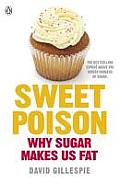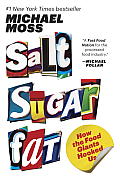There’s nothing wrong with being in the business of selling products that every human on the planet is hardwired to consume. The difference between sugar and tobacco is that the sugar industry has us all convinced it is our fault we’re fat, not theirs. [Page 192]
Sometimes you read a book and, while it is not particularly enjoyable, it leads you to another book that is truly profound. Recently, I struggled through Year of No Sugar: A Memoir by Eve Schaub. The concept was interesting, but the tone was liberal, privileged, and preachy. If you have ever watched an episode of The Goode Family you know exactly what I mean.
 However, that tome led me to David Gillespie’s Sweet Poison: Why Sugar Makes Us Fat. The author is an Australian lawyer, IT professional, consultant, and person who generally struggled with his weight following college like so many of us do. Working out and dieting did not work, so he set out to figure out what was structurally wrong with our food system.
However, that tome led me to David Gillespie’s Sweet Poison: Why Sugar Makes Us Fat. The author is an Australian lawyer, IT professional, consultant, and person who generally struggled with his weight following college like so many of us do. Working out and dieting did not work, so he set out to figure out what was structurally wrong with our food system.
Why is this a structural problem? If left to our own devices the human body will naturally tell us that we are full. However, we are very fat as a species and getting fatter. Why is such a beautifully engineered machine as the human body being subverted and making us fat? Sugar. More specifically, fructose. Our bodies, for some evolutionary reason, do not register calories consumed via fructose. Thus, we will continue to eat until we consume enough non-fructose calories.
Throughout most of human history this was not a problem because sugar was rare and expensive. The few pieces of ripe fruit, which also contain a lot of fiber, were not enough to upset the delicate balance our bodies orchestrate. Modern society has destroyed all of this by making fructose cheap and nearly ubiquitous.
Gillespie’s real triumph in this book is laying out the biochemical process in a clear, easy to understand way—trust me, biochemists and doctors are not known for writing accessible prose—that lays bare the fundamental failure of our modern food system.
You want to know how messed up the system is? We subsidize corn that is used to make high fructose corn syrup (HFCS) that is essentially killing us. If you live in the corn belt—like me here in Iowa—envision about half of the fields of corn being used to make HFCS. That is the scale of the problem. This is why it is a structural problem.
Furthermore, the problem is structural because foods that are not normally considered sweet—bread, cereal, etc.—have become veritable minefields of sugar laden pseudo-foods. Take a moment and consider the cereals we consider acceptable for breakfast. How are Lucky Charms, Trix, Fruity Pebbles, or anything similar considered anything but an occasional dessert instead of a breakfast cereal? No wonder we are fat. If you start the day off with one of these fructose bombs you might as well just schedule your trip to the endocrinologist for a diabetes checkup. It does not stop at breakfast.
The solution seems simple: cut out the sugar. In fact, the solution is that simple. In practice, it will be much harder but unless we want to look like the humans in Wall-E there is no other choice. Put down the Big Gulp. Now!






